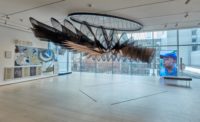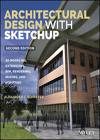The Making of a Jury
Some Personal Notes on the 11th Cycle of Aga Khan Awards for Architecture.
Of the 401 projects we saw on the first day, we decided that should a project have one vote, we would keep it. Three hundred were eliminated on that first day: out went all the skyscrapers and the monumental architecture of the star-architects building for the Gulf States and other less-wealthy Islamic countries. This seemed to coincide with my criteria of an ethical architectural theory: western-style high- rise development is neither climatically nor culturally suited to the Persian Gulf region and there must be other ways of displaying wealth and power than replicating Manhattan.
I understand that the price of land has made it mandatory to build skyscrapers in Manhattan, but what is the actual cost of land in the Gulf States when you’re building in the desert? And why should Muslims who are so attached to the earth, that in case of absence of water, they perform their ablutions with earth, live so far removed from the ground? (Souleymane, our philosopher, said that “Islam is incorporated into the soil.”) Why should the nomadic people of sand desert landscapes live so far up in the sky? At what price can all those glass facades be kept clean when there is so much dust and sand in the wind constantly blowing in from the sea? There are so many other issues questioning the adequacy of this western promotion.
The irony of it all is that most of this development is carried out with the promise of being ecological and sustainable. So much complicated engineering bloats the initial budget of these projects with the assurance that they will become sustainable in the future. I would like to see some of those architects and developers “sustain” themselves in the region! Would they be willing to spend 8 hours a day in the offices they have built there, or spend all their evenings in the apartments they have designed for that region? No doubt if those designs were transplanted to Paris, London or New York, they would become ideal places.
On our first day of work we had kept all the ecologically-minded projects, even those we were skeptical about, like the ones built on artificial lands gained from the sea. I know that half of the Netherlands is built on aquatic land, and parts of Manhattan, and Beacon Hill in Boston, and many other places whose histories I do not know, but is this a reason to repeat the same mistakes as in the past in these new regions? Ethically and aesthetically as well, I cannot relate to these artificial lands. I remember the first time we went to Dubai on vacation, my son was still a small boy interested in building sand castles, so off he went grating the sand and filling his pail: but great misfortune, after digging 20 centimeters, he hit the tarmac. We were sitting – not for long anyway since the sun is scorching hot – on an artificial beach with a shallow depth of sand, and I kept wondering if the sea itself was not a big artificial pool! I looked around at the long stretches of lawn and plush vegetation and the sprinklers working around the clock during daytime, and kept asking myself: is it really worth it? At what cost all this exuberant luxury in a desert climate? Is this what the tourists come to see on the Persian Gulf? I am so angry when I see Iran’s beautiful wild landscapes being slowly transformed into similar artificial paradigms.
On the second day of work we were down to 101 projects and had decided that only projects which had two votes would go to the next level, and here the real ecological-minded projects were sorted out from the ones which only had a veneer of green: all projects built on aquatic land and other suspicious-looking sustainable projects were dropped. The underlying consensus of the jury seemed to be a “return to Nature” in the Romantic lineage of Jean-Jacques Rousseau, Thoreau and Emerson, Konjian most ardently preaching this return. However, is it truly possible to go back to Nature when we have desecrated it for so long? As a landscape historian, it is most important for me to decide whether it is “natural” to build a Persian garden with all its canals and basins’ water being circulated by electric pumps, or should it done through gravity force as in the past. The Persian Garden is all about a stream of under or above ground water, which on its way to irrigate arable lands, lingers for a while in a garden for a moment of human enchantment. When water naturally flows in and out of the garden because of the gentle slope the gardener has created for it, it is a totally different story from the mechanical equipments we use nowadays, even though they may not be seen. Is this not similar to the 20-cm deep beach in Dubai? Unfortunately there were no new Persian Garden projects to further dwell on this sort of dilemma.
Finally we were applying an ethical judgment when we kept all the socially-minded projects: all the after-disaster projects and all those in the least-advantaged communities. We were in fact directly applying John Rawls’s second principle of Justice as “fairness” which could be vulgarized in one sentence: social and economic inequalities should be compensated to the benefit of the disadvantaged members of society.
On the third day we had ended up with 46 projects and in order to make the shortlist, we decided the projects should have a majority of votes, and since Anish Kapoor and Jean Nouvel couldn’t stay for the last day, that meant four votes.
After we shortlisted some twenty projects, the second round of deliberations was even more enlightening as to how much questions of ethics mattered more to all of us than mere aesthetics. I think that what makes the AKAA absolutely unique and outstanding in terms of judgment is that the projects are not judged on a documentation which falls short of reality. Most other juries have to do with a flat and dry presentation of the project since even films and 3-Drawings are presented in two dimensions. Human values are not discernible in this sort of presentation: who incited the creation of a project, who implemented it, who built it, who is using it? The technical reviewers are real people going to the real people involved at all levels of the making of a project, and especially the real people using the project, so they had a lot of influence on our final decisions. The presentations the technical reviewers made to us, in the course of four days, left little doubt as to what project really had merit for the final prize. One project was rejected because of fiscal fraud on the part of the developer. Another went down because it was built on public domain – too close to the sea, where no construction was allowed. A third one, we left out because it venerated more its Western architect than the community it was meant to serve. Another finalist project, very ecological-minded, was dropped when we realized how venal it was: clearly the architects were out to make money. Another project was disqualified because the users did not let the technical reviewers in! It was a “closed” building, a reflection of the closed community which had commissioned it. Another project was left out because the intentions announced by the client turned out to be different from the real motivation behind the building of the project. I want to stress the fact that as jury members, we were making judgments based on “fairness” much more than any other architectural issues. Even such a small fault as “not spelling out real intentions” was enough to drop a valuable work of architecture.
Seven projects ended up being totally “fair” with no scam from the initial intentions to the happy users. But by majority vote, we decided that the prize would have more impact with only five winners, since two of the final finalists were very similar to two of the final winners. The five winning projects were unanimously voted for by all jury members, except Anish Kapoor who couldn’t make this second round of deliberations. The Wadi Hanifa, a sunken oasis in the Riyadh region, we all saw as encouraging other cities in alleviating their pollution in a very structured way, Konjian calling it an ecological infrastructure. The rehabilitation of the French Avenue de la Marine in Tunis gave us hope that it would turn into the Champs Elysees of the city in the future, with no resentment to the colonial regime which had built it in the 19th century. The Madinat al Zahra Museum, epitomizing Spain’s searching anew for its Islamic roots as Soleymane so poetically put it, kept a low profile built into the ground adjacent to its archaeological site. The Bridge School enchanted us all by its aesthetics and cultural cleverness, and Jean Nouvel appreciated its impeccable details of steel and wood, saying that “I have not seen such fine detailing since Carlo Scarpa.” Finally Hanif Kara made such a great presentation of the Ipekyol factory that he convinced us it was the best place to work in if we were in the textile industry!
All throughout the jury deliberations we exerted our basic right of freedom of expression and demonstrated to ourselves the power of a democratic process of voting. Undoubtedly democracy is the best cradle for all human activities and even more so for creative activities, but unfortunately most Islamic countries are still far from achieving Democracy. For me one of our basic aims as architects, whose architecture is the producer of culture, should be to foster Democracy, with all its implicit concepts of freedom, equality, tolerance, pluralism... And somehow I think all the winning projects have the potential for generating a democratic bend in all those who come in contact with them.




